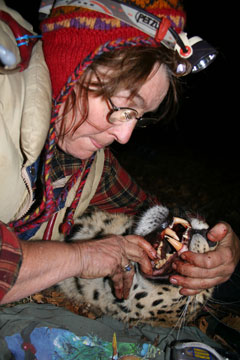World’s rarest cat captured in remote Russia
World’s rarest cat captured in remote Russia
mongabay.com
November 14, 2006
Wildlife Conservation Society (WCS) scientists captured a Far Eastern leopard in Southwest Primorski Krai in the southern Russian Far East, less than 20 miles from the Chinese border. With a wild population of 30, the Far Eastern leopard is the world’s most endangered big cat.
The leopard was captured in a “trapline”, examined, and released. During the examination, researchers took sperm samples to asses its capacity to reproduce. Researchers will use the samples to help determine whether the wild leopards suffer from the effects of inbreeding by closely related individuals. According to WCS, until now no information on the Far Eastern leopard has been available to assess the risk of disease or inbreeding.
The leopard was captured just a mile from where a large male Siberian tiger had been caught days earlier. The tiger is part of a subpopulation consisting of about 20 individuals in Southwest Primorye. Researchers conducted medical evaluations on the tiger as well.
 Melody Roelke of the Laboratory for Genomic Diversity, of the National Institute of Health — a specialist in large felid genetics and disease — conducting a thorough medical exam of the captured Far Eastern leopard. Photo credit: John Goodrich/Wildlife Conservation Society |
“This capture represents a milestone in our cooperative efforts to save the Far Eastern leopard and Siberian tiger from extinction,” said Dale Miquelle, Director of the Wildlife Conservation Society’s Russia Program, which has led coordination of this project. “With the information gained from these animals, and others to come, we will be in a much better position to determine appropriate conservation actions.”
WCS says that if inbreeding proves to be a significant problem, new genetic material may be introduced into the population, by bringing in big cats from other part of the species’ range, as was done for the Florida panther. A media release from WCS explains: “In that situation, when poor reproduction and physical abnormalities suggested that inbreeding was the culprit, pumas from Texas were introduced into Florida, resulting in increased reproductive rates and greater vitality of the Florida population.”
More news on tigers
Tiger fur trade thrives in China.
The illegal tiger and leopard fur trade continues to thrive in China according to recent investigations by the Environmental Investigation Agency (EIA) and the Wildlife Protection Society of India (WPSI). The organizations say that the trade is “operating without any hindrance from the Chinese government” and endangers surviving wild tiger populations in India.
Tiger habitat declining. The most comprehensive scientific study of tiger habitats ever done finds that the big cats reside in 40 percent less habitat than they were thought to a decade ago. The tigers now occupy only 7 percent of their historic range.
Venture capitalists fund tiger conservation program. A new program that calls for a 50 percent increase in tiger numbers in key areas over the next decade blends a business model with hard science and has already attracted $10 million from venture capitalists according to an article published in the current issue of the journal Nature.














